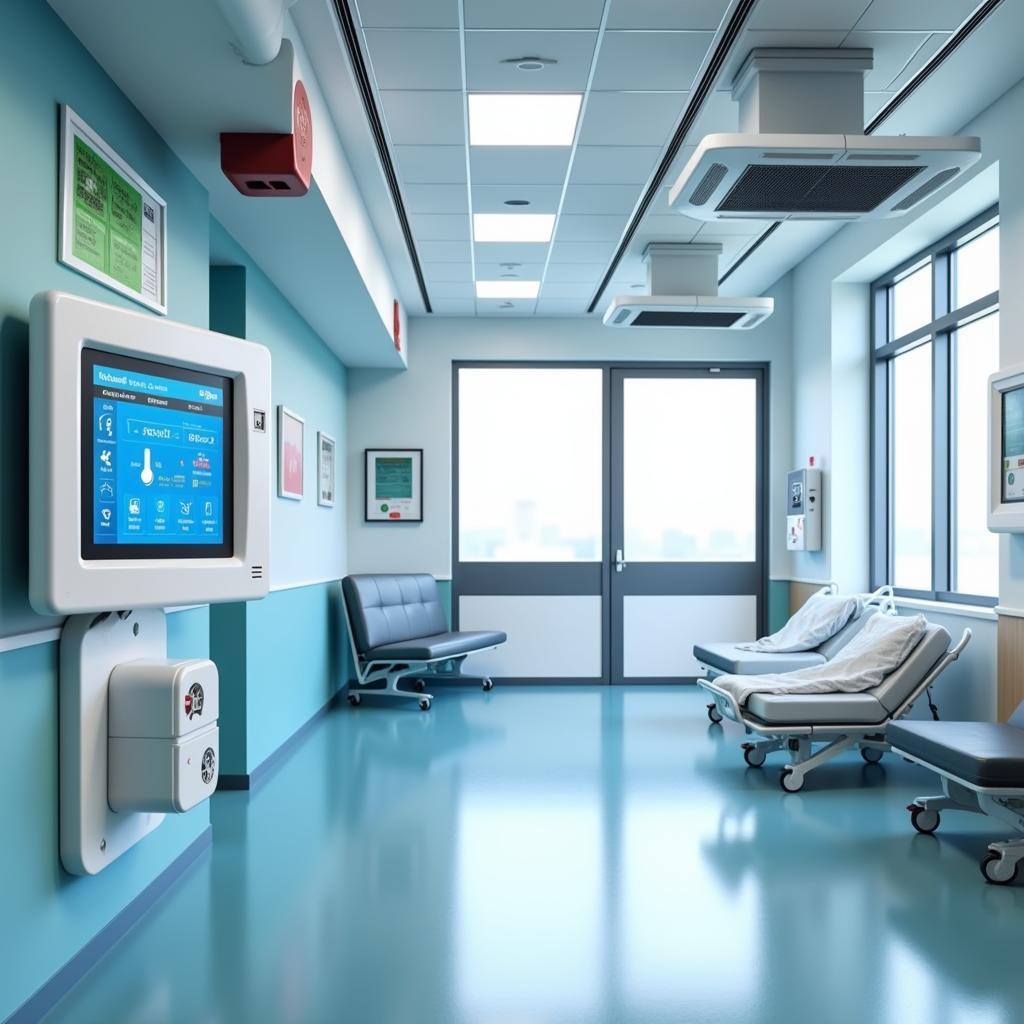Maintaining optimal temperature and humidity levels within a hospital environment is crucial for patient comfort, safety, and well-being. Hospital Temperature And Humidity Policy dictates these conditions, impacting everything from infection control to medication efficacy. Understanding this policy is essential for both healthcare professionals and patients.
The Importance of a Hospital Temperature and Humidity Policy
Temperature and humidity influence a patient’s ability to heal and fight infection. Too much humidity can promote the growth of mold and bacteria, while too little can dry out mucous membranes, making patients more susceptible to respiratory illnesses. Temperature extremes can also negatively affect patients, particularly the very young and the elderly. A robust hospital temperature and humidity policy ensures a safe and comfortable environment.
Key Factors Influencing Hospital Temperature and Humidity Control
Several factors influence the development and implementation of a hospital temperature and humidity policy. These include the type of patient population served, the specific climate of the region, and the types of medical procedures performed. For instance, operating rooms require stricter temperature and humidity control compared to general patient rooms. Additionally, the age and health status of the patient population can influence ideal temperature settings.
 Hospital Temperature and Humidity Control System
Hospital Temperature and Humidity Control System
Regulations and guidelines also play a critical role. Organizations such as the ASHRAE (American Society of Heating, Refrigerating and Air-Conditioning Engineers) provide recommendations for acceptable temperature and humidity ranges in healthcare facilities. These recommendations serve as a foundation for many hospital policies, ensuring a consistent standard of care across different institutions.
Understanding the Components of a Hospital Temperature and Humidity Policy
A comprehensive hospital temperature and humidity policy typically covers several key areas. These include specific temperature and humidity ranges for different areas within the hospital, regular monitoring and recording procedures, maintenance schedules for HVAC systems, and protocols for addressing deviations from the established ranges. The policy also outlines staff responsibilities and training requirements related to temperature and humidity management.
Temperature and Humidity Ranges in Different Hospital Areas
Different areas within a hospital may require specific temperature and humidity settings. Operating rooms, for instance, often require cooler temperatures to reduce the risk of infection. Neonatal intensive care units (NICUs), on the other hand, require warmer temperatures to maintain the body temperature of newborns. The hospital temperature and humidity policy outlines these specific requirements, ensuring the optimal environment for each patient population.
 Hospital Room Temperature Control
Hospital Room Temperature Control
Monitoring and Maintaining Optimal Conditions
Regular monitoring and maintenance are essential to ensuring compliance with the hospital temperature and humidity policy. This includes routine inspections of HVAC systems, calibration of monitoring equipment, and documentation of temperature and humidity readings. Regular maintenance prevents system failures and ensures optimal performance, contributing significantly to patient comfort and safety.
Benefits of a Robust Temperature and Humidity Policy
Implementing a well-defined hospital temperature and humidity policy offers several key benefits. It minimizes the risk of hospital-acquired infections, improves patient comfort and satisfaction, and enhances the overall safety of the healthcare environment. A consistent and well-managed environment also contributes to improved staff morale and productivity.
Impact on Patient Health and Well-being
Maintaining optimal temperature and humidity levels has a direct impact on patient health and well-being. A comfortable environment can reduce stress and anxiety, promote better sleep, and contribute to faster recovery. Controlling humidity also minimizes the spread of airborne pathogens, reducing the risk of infection.
 Comfortable Hospital Room
Comfortable Hospital Room
“Maintaining a comfortable and safe environment for our patients is paramount,” says Dr. Amelia Carter, Chief of Internal Medicine at San Jose Hospital. “Our hospital temperature and humidity policy ensures that we provide the best possible conditions for healing and recovery.”
Common Questions about Hospital Temperature and Humidity
What is the ideal temperature for a hospital room? While specific ranges vary, most hospital rooms are kept between 68-75°F (20-24°C).
How often is temperature and humidity monitored in hospitals? Monitoring frequency can vary, but it is typically done at least once per shift, and often more frequently in critical care areas.
What happens if the temperature or humidity goes outside the acceptable range? The hospital has procedures in place to address deviations, including contacting maintenance personnel and implementing temporary measures to restore optimal conditions.
“Regular monitoring and proactive maintenance are essential components of our policy,” adds Dr. Carter. “We are committed to providing our patients with a safe, comfortable, and healing environment.”
Conclusion
A robust hospital temperature and humidity policy is essential for providing high-quality patient care. By ensuring optimal environmental conditions, hospitals can improve patient comfort, reduce the risk of infections, and promote a faster recovery. San Jose Hospital prioritizes patient well-being and adheres to a strict temperature and humidity policy to maintain a safe and comfortable environment.
 Modern Hospital HVAC System
Modern Hospital HVAC System
FAQ
- How does humidity affect patient health?
- What are the ASHRAE guidelines for hospital temperature and humidity?
- Can patients adjust the temperature in their rooms?
- Who is responsible for maintaining the HVAC systems in a hospital?
- What is the procedure for reporting temperature and humidity concerns?
- How often are HVAC systems inspected in a hospital?
- What are the consequences of not adhering to the hospital’s temperature and humidity policy?
Need support? Contact us at Phone Number: 02437655121, Email: [email protected] Or visit us at: No. 298 Cau Dien Street, Minh Khai Ward, Bac Tu Liem District, Hanoi, Vietnam. We have a 24/7 customer service team.